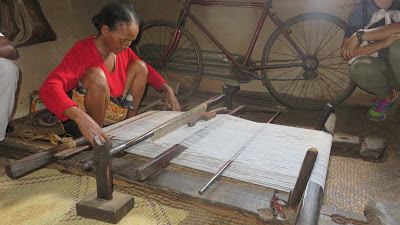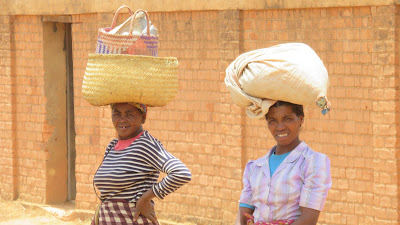School bus rickshaws.
Working the fields.
The village children welcome us.
Drying rice.
Silk weaving.
The outdoor silk scarf shop.
Using the zebu to break up the mud lumps.
The beautiful rice paddy landscape.
The future lord of the valley.
Monday,
November 6th.
We
started out at 7:30 and drove a couple of hours through the highlands
and past lots of rice paddies. I find them very beautiful, they way
they transform the land into small flat areas surrounded by little
barriers, the vibrant green of the plant and the water shimmering in
the light. And it is interesting to watch the people working in them
(although I am glad it isn't me), planting or plowing or walking the
zebu around to break up the mud lumps in the dry ones.
We
were travelling on NR7 and turned off on a secondary half paved road
and got an 'African massage' for about an hour until we arrived at
the Maintsovolo Community Tapia Tree Management Cooperative. This is
a community that is funded by a British agency called Feedback
Madagascar to help a community of women who weave silk into shrouds
for the dead and now scarves for tourists. Intrepid loves to help
sponsor these type of cooperatives as a means of giving back and
modelling sustainable tourism. This is their first project in
Madagascar and they take all of their tours here. We were met by a
local guide who represents the cooperative agency here that manages
the Tapia tree forest. He gave us a tour through the forest
explaining the relationships between the tapia trees and others in
the forest. Silkworms feed on tapia trees. There is a second variety
at feeds on mulberry bushes. He showed us a couple of silkworm
cocoons and a new cage they have built to try to get the moths to
breed in it. He explained the life cycle of the silkworm.
After
that we drove on a dirt road to the actual community of Maintsovolo
and had the process of boiling, curing, and drying the cocoons
explained us and had a weaving demonstration. After that they took us
to their 'shop' which was out on the ground. Quite a few people in
the group bought a scarf or two as presents and a way of helping
support the community. This is much better than handing out money to
beggars. We had a traditional lunch there too prepared by the
community. We had chicken, rice and beans with burnt rice tea.
We
left there around 12:30 and had a five hour drive ahead of us along
very winding, narrow roads to get to our accommodation for the night.
However, as in most of these developing countries, sitting on the bus
and looking out the window is endlessly fascinating. You see things
that you would never see at home and wonder how they work. I love
watching the people going about their lives. We stopped a few times
for scenic views, or bushy bushy visits and took photos out the
windows. Two of the women on our trip were sick at one of the
viewpoints, motion sickness?
As we
drove into the rainforest highland area we were pulled over for a
health check. We all had to get off the bus and have our temperature
taken by a sensor. Thankfully we all passed. We arrived at our camp
for the night just at dusk. We are now in a nice cabin type hotel
just outside Ranomafana NP. By the time we arrived two more people
were feeling poorly and couldn't make dinner. We had dinner at the
hotel restaurant, listened to tomorrow's itinerary and the list of
things we need to bring for our hike. Then off to bed.












Such different landscape than the first tour
ReplyDeletelove the school transportation
Thinking the temperature check is to verify that a person is not infected with the plague, correct? Glad you passed. What happens if a person does not?
ReplyDelete